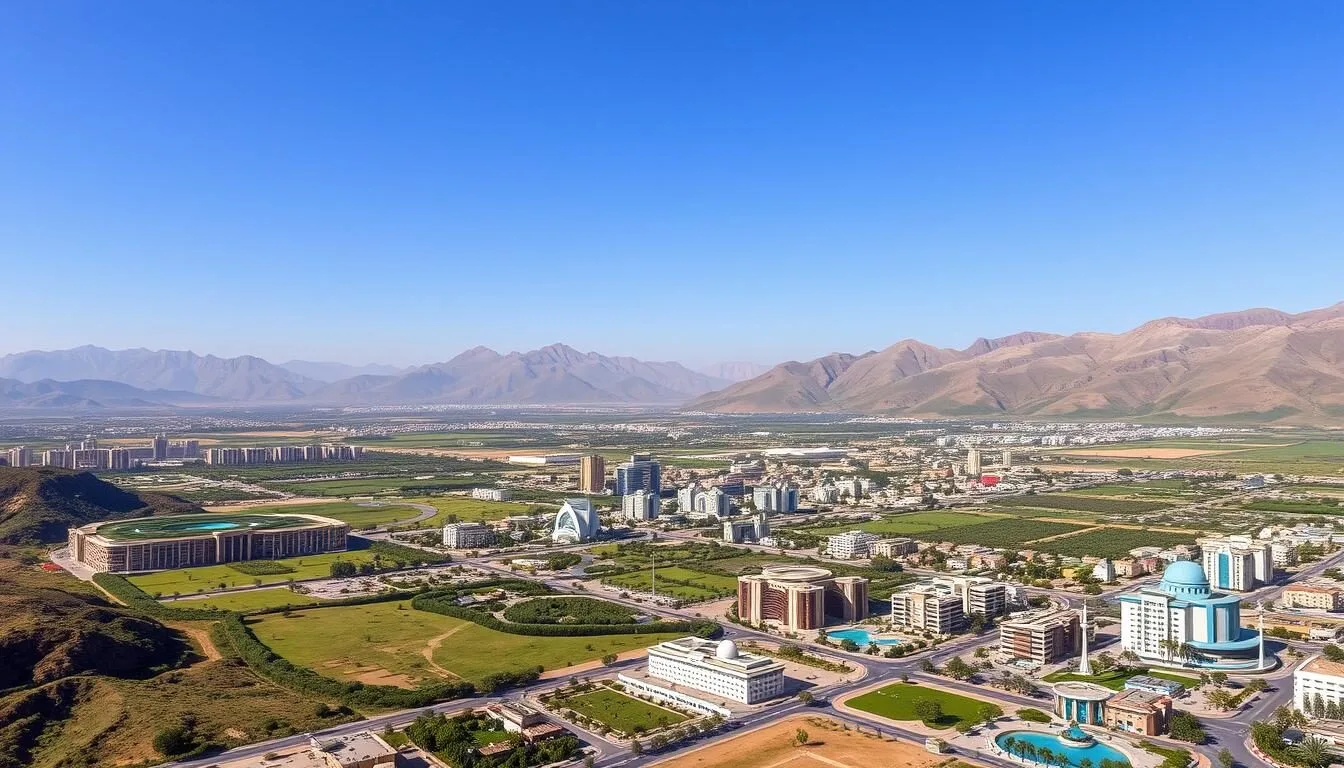Did you know that Abha sits at a breathtaking 2,270 meters (7,450 feet) above sea level, making it Saudi Arabia’s coolest summer escape? This verdant mountain city defies all expectations of the Arabian Peninsula, with temperatures rarely climbing above 35°C (95°F) even in peak summer months. Known as the “Bride of the Mountain,” Abha offers a refreshing alternative to the kingdom’s typically arid landscapes with its misty peaks, lush valleys, and vibrant cultural scene.
Getting There & Planning Your Journey
Aerial view of Abha nestled in the Asir Mountains
Reaching this mountain sanctuary has become increasingly accessible, with multiple transportation options available to travelers. Whether you prefer the convenience of air travel or the scenic adventure of a road trip, Abha welcomes visitors through various gateways.
By Air: Abha International Airport
Abha International Airport serves as the primary aerial gateway to the Asir Region, located just 16 kilometers from the city center. The airport connects to 10 destinations across 3 countries, with flights operated by several carriers including Saudi Arabian Airlines (Saudia), Flynas, flyadeal, Qatar Airways, and Air Arabia.
Flight durations from major Saudi cities are relatively short:
- Riyadh to Abha: 1.5 hours
- Jeddah to Abha: 1 hour
- Cairo to Abha: 2 hours 45 minutes
Ready to Book Your Flight to Abha?
Find the best deals on flights to Abha from major cities worldwide.
By Road: Scenic Drives Through Changing Landscapes
Road journeys to Abha transform transportation into exploration, revealing Saudi Arabia’s dramatic topographical transitions. The highway infrastructure connecting major centers to Abha maintains excellent standards, making road trips a viable option for adventurous travelers.
- Riyadh to Abha: Approximately 1,000 kilometers (621 miles), 10-hour drive
- Jeddah to Abha: Approximately 600 kilometers (373 miles), 7-hour drive
- Dammam to Abha: Approximately 1,353 kilometers (841 miles), 13-hour drive
These drives unveil one of Saudi Arabia’s most captivating geographical narratives—the gradual metamorphosis from desert expanses to verdant mountain terrain. Winding mountain roads carve through dramatic topography, offering successive revelations of the region’s stunning vistas.
Explore Abha at Your Own Pace
Rent a car and discover the scenic beauty of the Asir region on your schedule.
Map of Abha, Saudi Arabia
Best Time to Visit Abha
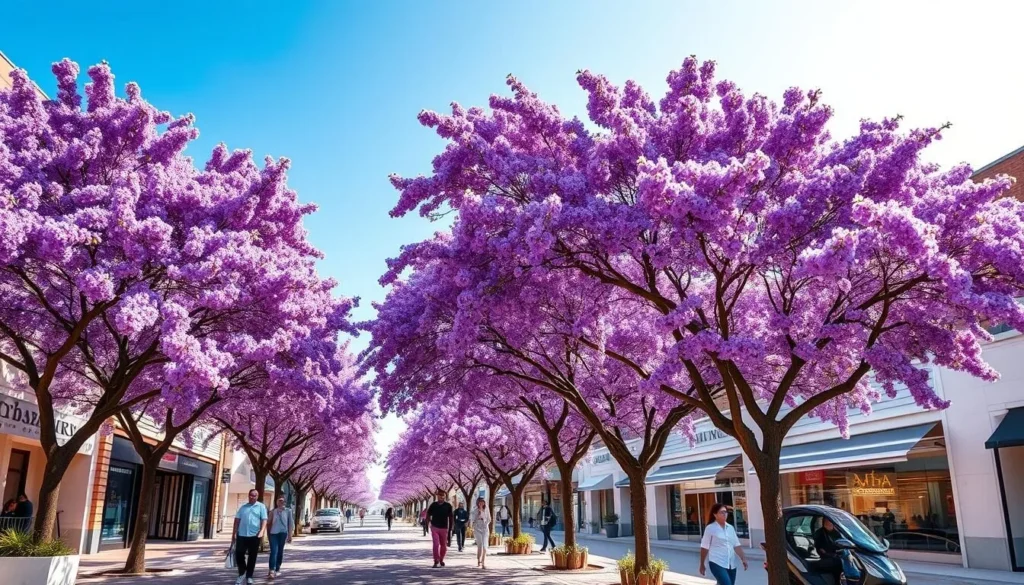
Jacaranda trees in full bloom along Art Street during spring
Abha’s elevated position grants it a unique climate that sets it apart from the rest of Saudi Arabia. The city enjoys a moderate temperature year-round, making it a popular retreat during the scorching summer months when other parts of the kingdom experience extreme heat.
Recommended Months to Visit
- March to May (Spring): Temperatures range from 15°C to 25°C (59°F to 77°F). This is when the famous jacaranda trees bloom, creating stunning purple canopies throughout the city.
- June to September (Summer): Peak tourist season with temperatures between 18°C to 30°C (64°F to 86°F). While the rest of Saudi Arabia swelters, Abha remains pleasantly cool.
- October to November (Fall): Mild temperatures from 12°C to 22°C (54°F to 72°F) with clear skies, perfect for outdoor activities.
Months to Avoid
- December to February (Winter): Temperatures can drop to 5°C (41°F) at night, and the region experiences fog that may limit visibility at popular viewpoints. Some attractions may have reduced hours.
Weather Tip: Abha receives up to 500 millimeters of annual rainfall, primarily during August (approximately 219 millimeters). Pack a light raincoat if visiting during the summer months, and always bring layers as mountain temperatures can fluctuate significantly between day and night.
Getting Around Locally
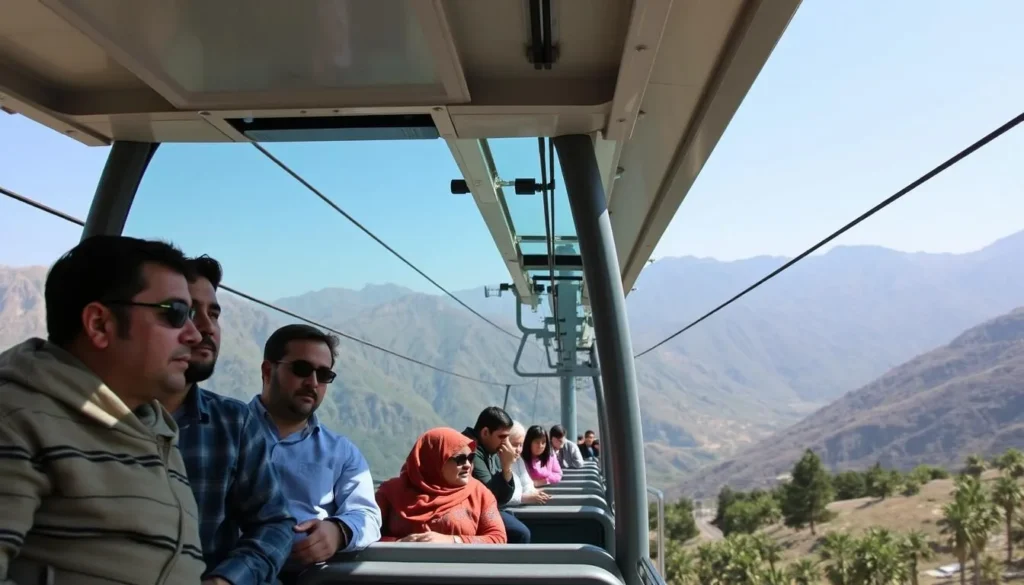
Abha’s cable car system offering panoramic mountain views
Navigating Abha and its surrounding attractions requires some planning, but the city offers several transportation options to help you explore efficiently.
Rental Cars
Having your own vehicle provides the most flexibility for exploring Abha and the wider Asir region. Major international and local car rental companies operate at Abha International Airport and in the city center. A 4WD vehicle is recommended if you plan to venture into the mountains or visit remote villages like Habala.
Freedom to Explore
Secure your rental car in advance for the best rates and vehicle selection.
Taxis and Ride-Sharing
Taxis are readily available in Abha and can be hailed on the street or booked through your hotel. Ride-sharing apps like Uber and Careem also operate in the city, offering convenient and often more affordable transportation options.
Public Transportation
The Saudi Public Transport Company (SAPTCO) operates bus services within Abha and between neighboring cities like Khamis Mushait. A recent five-year contract worth 112.99 million Saudi riyals has enhanced public transport operations across Abha, Khamis Mushait, and Ahad Rufaidah, making it easier for visitors to navigate the area.
Cable Cars
Abha’s cable car system is both a transportation method and an attraction in itself. Four distinct routes thread through the mountain landscape, offering unique perspectives on the Sarawat range. The most remarkable connects to the Abha Palace Hotel Station, suspended between just two pillars across a full kilometer—an engineering feat that may be unique worldwide.
Where to Stay
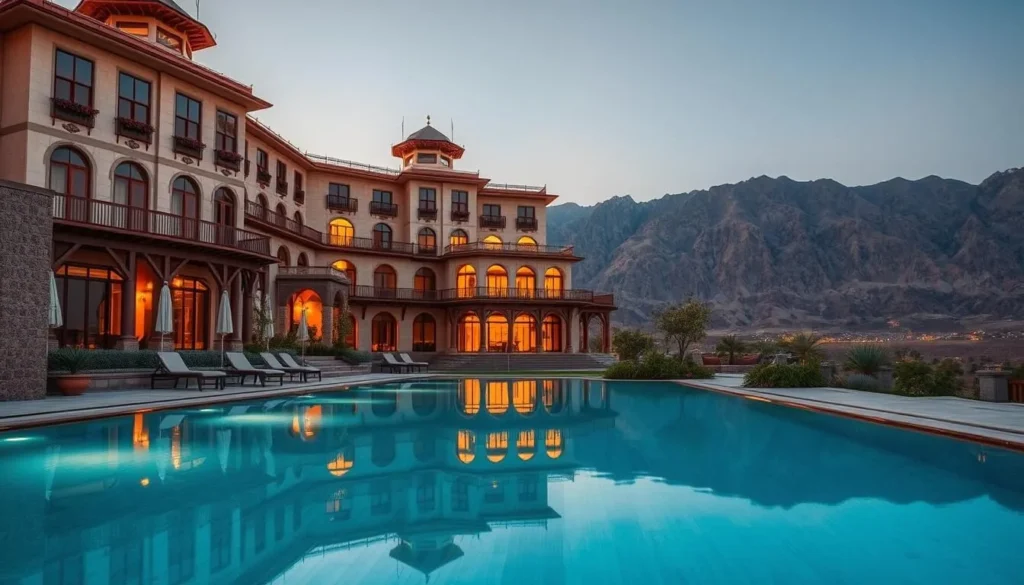
Luxury accommodation in Abha with stunning mountain views
Abha offers a range of accommodation options to suit different budgets and preferences. From luxury hotels with panoramic mountain views to more affordable options in the city center, you’ll find comfortable places to rest after a day of exploration.
Luxury Hotels
Abha Palace Hotel stands as the city’s premier luxury option, commanding a prime position along the shores of Al Sad Lake. Guest rooms frame panoramic vistas of both the tranquil waters and the dramatic mountain amphitheater beyond. This 5-star establishment provides spacious quarters equipped with contemporary amenities including flat-screen televisions, mini-bars, and private bathrooms. The hotel’s wellness facilities include a spa complex, indoor swimming pool, sauna, and hot tub.
Mid-Range Options
Citadines Abha presents a modern alternative positioned along King Fahd Road, strategically placed between Abha and Khamis Mushait. These apartment-style accommodations offer more space and often include kitchenettes, making them ideal for families or longer stays.
Budget-Friendly Stays
Several budget hotels and guesthouses can be found throughout Abha, offering clean, comfortable rooms at affordable rates. While they may lack the amenities of higher-end properties, they provide a practical base for exploring the region.
Find Your Perfect Stay in Abha
Browse accommodations ranging from luxury hotels to budget-friendly options.
Dining & Local Cuisine
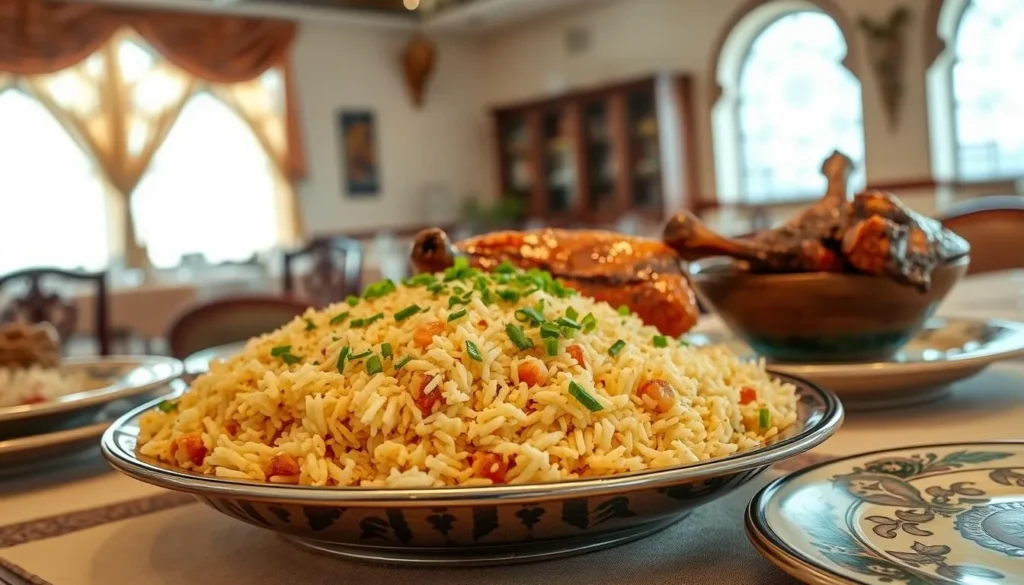
Traditional Kabsa dish, a Saudi Arabian specialty found throughout Abha
The culinary scene in Abha reflects both national Saudi flavors and regional mountain specialties. The cooler climate and agricultural abundance of the Asir region influence local dishes, which tend to be heartier than those found in other parts of the kingdom.
Must-Try Local Dishes
- Kabsa: Saudi Arabia’s national dish—aromatic rice infused with cloves, cardamom, saffron, and cinnamon, topped with tender chicken, lamb, or occasionally camel meat.
- Haneeth: Meat slow-cooked in outdoor iron pots or specialized sand pits called “mahnaz,” traditionally accompanied by rice. The mountain version has its own distinct flavor profile.
- Mandi: Similar to Kabsa but prepared in tandoor ovens, giving it a unique smoky flavor.
- Aseeda: A substantial wheat flour porridge customarily consumed using three fingers, reflecting ancient eating traditions. It’s often served with honey or ghee.
- Mountain Honey: The Asir region produces some of Saudi Arabia’s finest honey varieties, each reflecting the diverse flora of the mountains.
Where to Eat
Abha offers dining options ranging from traditional local eateries to international restaurants. For an authentic experience, head to the restaurants near Souq Al Thulatha (Tuesday Market) where you can sample local specialties in a traditional setting. Many hotels also house restaurants serving both local and international cuisine.
Dining Tip: Most restaurants in Abha have separate sections for families and single men, following Saudi cultural norms. Some establishments may also close during prayer times, so plan your meals accordingly.
Attractions, Sightseeing & Activities
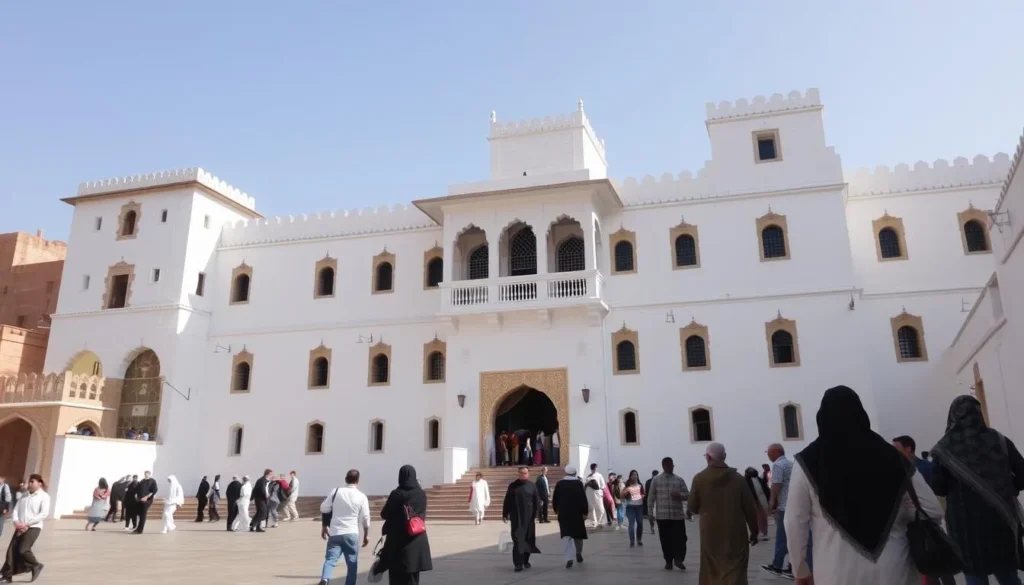
Historic Shadda Palace showcasing traditional Asiri architecture
Abha’s attractions reveal layers of cultural depth and natural wonder that distinguish this mountain realm from Saudi Arabia’s more familiar landscapes. Each destination tells a story of adaptation, artistry, and the remarkable ways human settlements have flourished in these elevated terrains.
Art Street and Jacaranda Trees
The creative pulse of Abha beats strongest along Art Street, where artistic expression mingles with one of nature’s most spectacular seasonal displays. Spring awakens over 15,000 jacaranda trees throughout the city, creating a purple cathedral of blossoms that transforms Art Street into a tunnel of violet light. This pedestrian thoroughfare houses approximately 10 art galleries, each offering glimpses into local creative traditions, while cafes provide perfect vantage points for observing the floral spectacle.
Shadda Palace and Historical Forts
Shadda Palace stands as a testament to Abha’s administrative heritage, its origins reaching back to 1820 when it served as the region’s primary seat of governance. The structure now functions as a museum, preserving traditional utensils, period furniture, antique coins, and early photographic records that chronicle local life across generations. Built in 1927 for the provincial governor, the palace exemplifies traditional Asiri architectural principles – high walls and strategically minimal windows that prioritized privacy and protection.
Cable Car Experiences
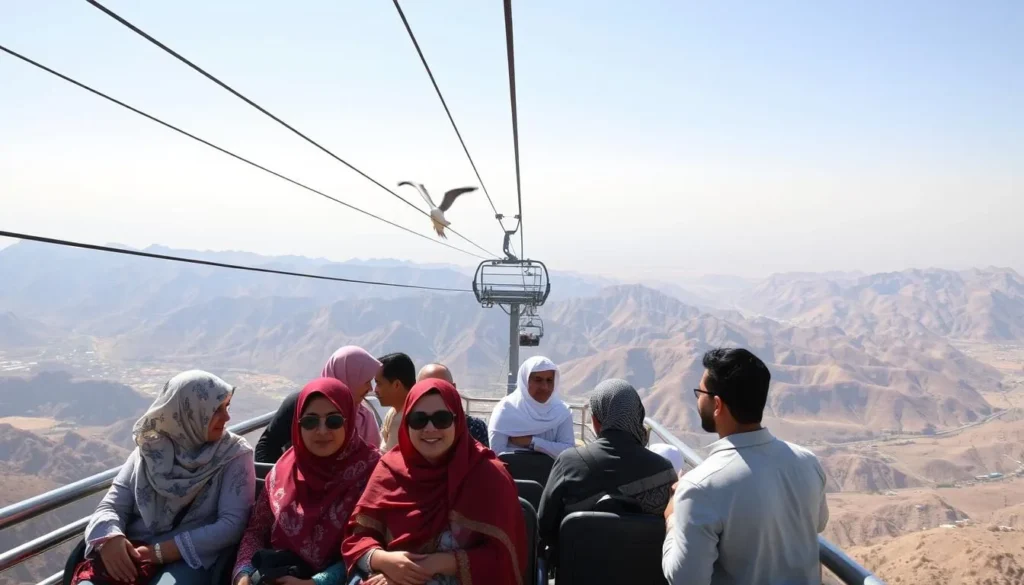
Cable car ride offering breathtaking views of the Asir Mountains
Four distinct cable car routes thread through Abha’s mountain landscape, each offering unique perspectives on the Sarawat range’s dramatic topography. The most remarkable of these aerial journeys connects to the Abha Palace Hotel Station, suspended between just two pillars across a full kilometer. These elevated vantage points reveal the full scope of the surrounding peaks, with optimal viewing conditions occurring during early morning and late afternoon hours.
Habala Hanging Village
Habala Village clings to cliff faces in what appears to be a gravity-defying feat of traditional engineering. Stone dwellings feature intricate architectural details and wooden balconies that seem to grow organically from the rocky mountainside. The village’s name derives from the rope ladders (“habals”) that once provided the only access to these precipitous homes, though today a 600-meter cable car route connects visitors to this aerial community.
Experience Abha’s Top Attractions
Book guided tours to Abha’s most fascinating sites with knowledgeable local guides.
Traditional Markets and Shopping
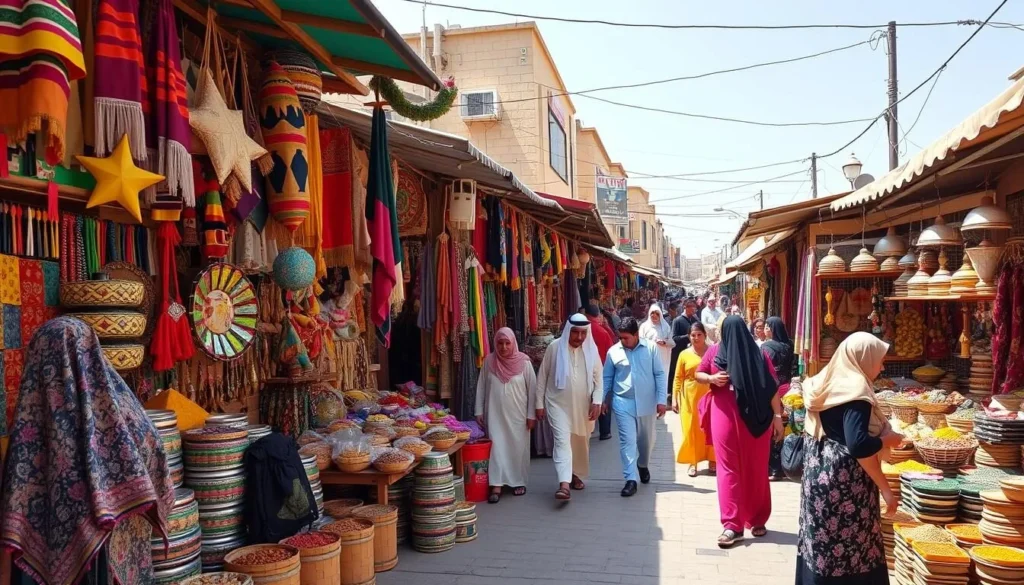
Vibrant stalls at Souq Al Thulatha (Tuesday Market) in Abha
Shopping in Abha offers a blend of traditional market experiences and modern retail options. The markets provide insight into local crafts and products while serving as important social and cultural hubs.
Souq Al Thulatha (Tuesday Market)
Souq Al Thulatha represents the region’s most significant traditional marketplace, where centuries-old trading practices continue. The market displays traditional garments, handicrafts, jewelry, and honey varieties that reflect the area’s agricultural prosperity. This vibrant market is not just a shopping destination but a cultural experience where you can observe local commerce and social interactions.
Al Muftaha Art Village
Al Muftaha Art Village specializes in artisan creations, featuring paintings, pottery, and handcrafted items produced by local artists. This creative hub showcases the artistic traditions of the Asir region and offers unique souvenirs that reflect local cultural heritage.
Modern Shopping
For those seeking contemporary retail experiences, Abha Mall caters to modern shopping preferences with international and domestic brands. Meanwhile, Agrab Market maintains a traditional market atmosphere through stalls offering spices, perfumes, handicrafts, and textiles.
Shopping Tip: Bargaining is expected in traditional markets, but approach it as a friendly conversation rather than an aggressive negotiation. Start by offering about 60-70% of the asking price and work toward a mutually agreeable figure.
Cultural Gems & Festivals
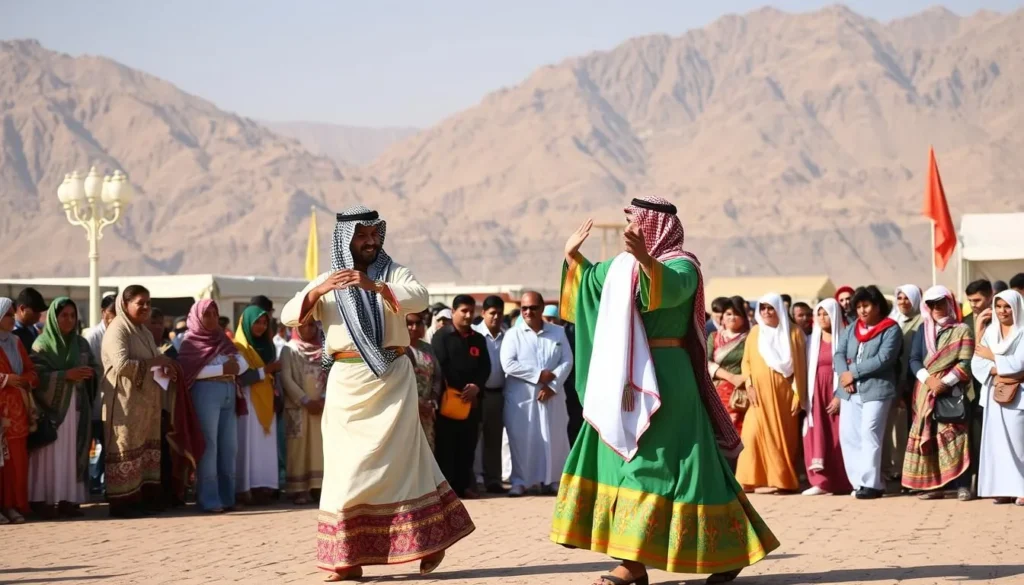
Traditional dancers performing during Abha’s Summer Festival
Abha’s cultural scene is as rich and varied as its natural landscape. The city and surrounding region preserve unique traditions that have evolved in isolation among the mountains of Asir.
Abha Summer Festival
The annual Abha Summer Festival coincides with the peak tourist season, offering a vibrant showcase of local culture, music, and traditions. The festival features traditional dance performances, handicraft exhibitions, and cultural activities that provide insight into the region’s heritage. The Jacaranda Season festival at Al Muftaha Village marks the peak of the botanical celebration, drawing visitors who come specifically to witness the remarkable color transformation of the city.
Al-Muftaha Village
Beyond its role as an art center, Al-Muftaha Village serves as a living museum of Asiri culture. The village’s architecture exemplifies traditional building techniques, with colorful geometric patterns adorning many structures. Artists work in studios open to visitors, providing demonstrations of traditional crafts and painting techniques.
Traditional Architecture
The distinctive architectural style of the Asir region can be observed throughout Abha and surrounding villages. Multi-story stone houses feature bright colors and intricate patterns, with small windows designed to maintain privacy while allowing for ventilation. These structures represent centuries of adaptation to the mountain environment and reflect the region’s unique cultural identity.
Nature & Outdoor Adventures
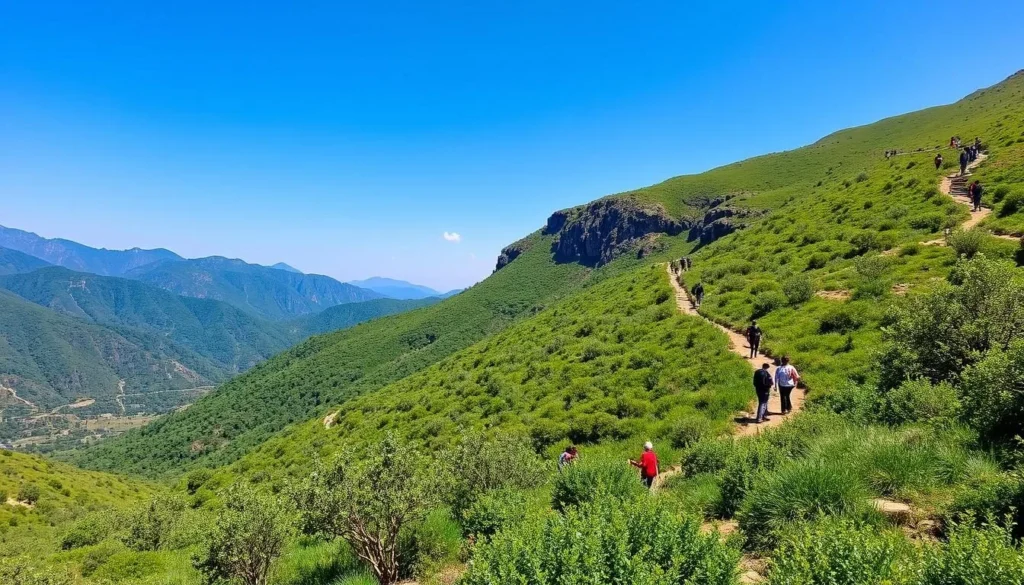
The verdant landscapes of Asir National Park near Abha
The ecological tapestry surrounding Abha reveals a natural phenomenon that defies the Arabian Peninsula’s conventional image. These mountain slopes harbor ecosystems that flourish where desert conditions typically prevail, creating outdoor sanctuaries that beckon both scientific curiosity and adventurous exploration.
Asir National Park and Garf Raydah Reserve
Raydah Natural Reserve occupies 9.33 square kilometers of protected wilderness, established in 1989 as a sanctuary for some of Arabia’s most elusive wildlife. This ecological haven shelters the Arabian Wolf, Caracal, Rock Hyrax, Mongoose, and Nubian Ibex within its boundaries. Ornithological treasures include the Yemen thrush, Arabian Red-Legged Partridge, Arabian Woodpecker, and Yemen Linnet – species that represent the region’s unique biogeographical position.
The reserve’s topography tells a story of water and stone, where steep slopes bear dense vegetation dominated by ancient juniper trees. Water tributaries carve their descent from cliff summits into Raydah Valley below, creating microclimates that nurture life.
Hiking and Viewpoints in the Sarawat Mountains
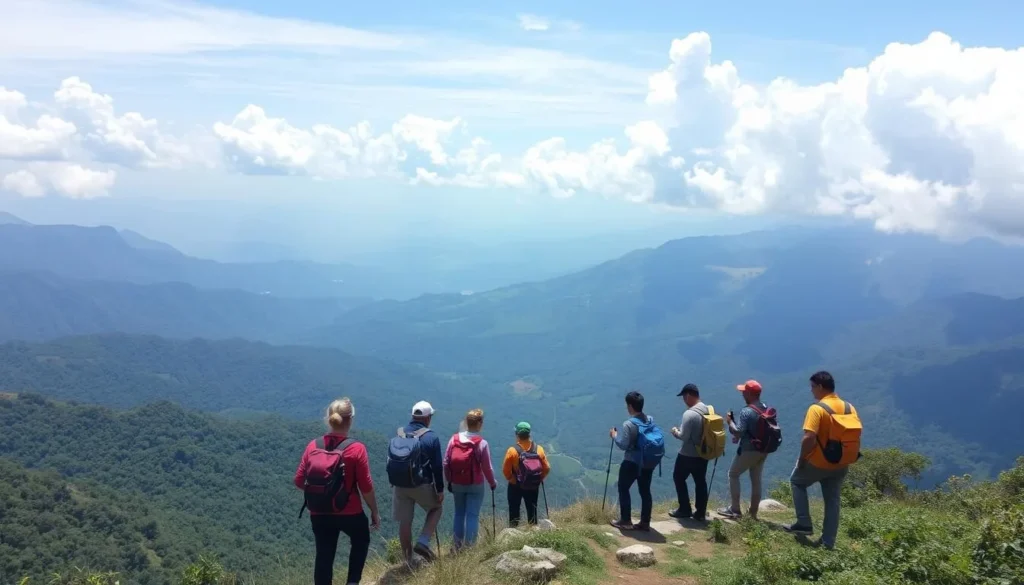
Hiking trails in the Sarawat Mountains offer spectacular vistas
The Sarawat range contains Saudi Arabia’s most elevated terrain, crowned by Jabal Sawda at 3,133 meters (10,279 feet) above sea level. Ancient footpaths weave through these heights, some tracing routes established 250 years ago by mountain communities. Jebel Al-Akhdar (Green Mountain) rises to 2,340 meters (7,677 feet), offering commanding perspectives across Abha’s urban sprawl.
Photographers and sunrise enthusiasts gravitate toward Abha Lake Viewpoint, where light transforms the landscape during dawn and dusk hours. The mountain passages known as “Aqabat” represent engineering marvels carved through solid rock. Aqabat Al-Dhala in Rijal Almaa extends 11 kilometers (6.8 miles) through tunnels and strategic viewpoints that frame the surrounding wilderness.
Discover Abha’s Natural Wonders
Book guided hiking tours, wildlife excursions, and outdoor adventures in the Asir Mountains.
Safety, Etiquette & Local Customs
Visiting Abha requires awareness of both general Saudi cultural norms and some region-specific considerations. Understanding and respecting local customs will enhance your experience and help you navigate social situations appropriately.
Dress Code
While Saudi Arabia has relaxed some of its dress code requirements for foreign visitors in recent years, modest attire is still expected, especially in more conservative areas like Abha. Women should wear loose-fitting, non-transparent clothing that covers shoulders, arms (to the elbow at least), and knees. Men should avoid shorts and sleeveless shirts in public areas.
Photography
Always ask permission before photographing local people, especially women. Some traditional communities may be sensitive about photography. Government buildings, military installations, and airports should not be photographed. However, most tourist attractions welcome photography.
Prayer Times
Businesses, including restaurants and shops, may close briefly during prayer times, which occur five times daily. Plan your activities accordingly, especially if visiting during meal times.
Gender Segregation
Some restaurants and cafes in Abha may have separate sections for families (where women can enter) and single men. This practice is becoming less common in tourist areas but is still observed in more traditional establishments.
Safety Tip: Abha is generally very safe for tourists, with low crime rates. However, the mountain roads can be challenging, especially in foggy or rainy conditions. Drive cautiously and consider hiring a local driver if you’re uncomfortable navigating the winding mountain routes.
Practical Travel Tips
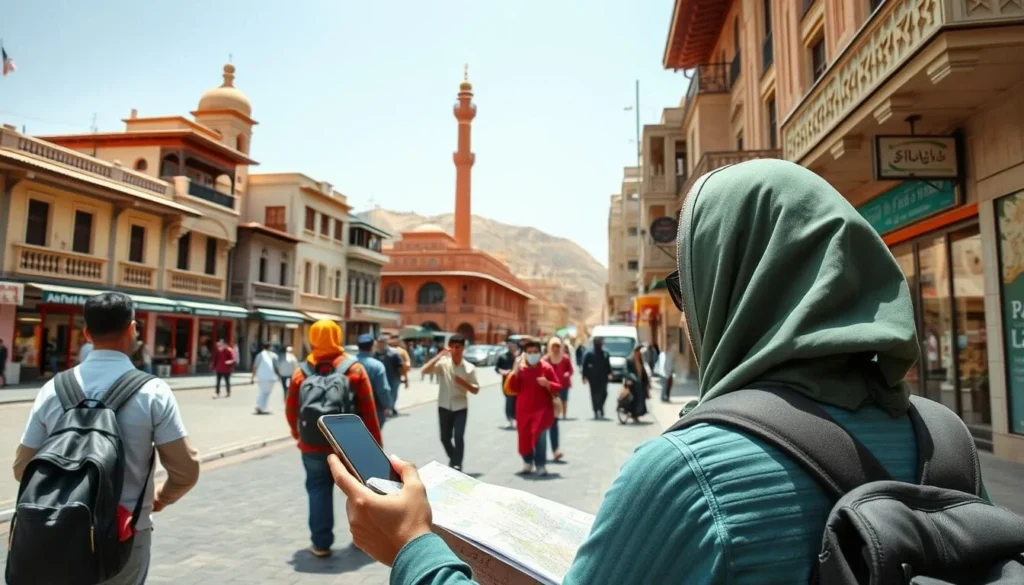
Navigating Abha with modern technology and traditional maps
These practical tips will help you navigate your visit to Abha smoothly and make the most of your time in this unique destination.
Currency and Payments
The Saudi Riyal (SAR) is the local currency. ATMs are widely available in Abha, and major credit cards are accepted at hotels, larger restaurants, and shopping malls. However, it’s advisable to carry some cash for smaller establishments, traditional markets, and rural areas.
Language
Arabic is the official language, but English is widely understood in tourist areas, hotels, and restaurants. Learning a few basic Arabic phrases can enhance your experience and is appreciated by locals. The Asir region has its own dialect, but standard Arabic is understood everywhere.
Internet and Connectivity
Mobile coverage is good throughout Abha and surrounding tourist areas. Most hotels offer Wi-Fi, and prepaid SIM cards with data packages are available for purchase at the airport and in city shops (passport required for registration).
Health and Altitude
Abha’s high altitude (2,270 meters/7,450 feet) may cause mild altitude symptoms in some visitors. Stay hydrated and allow time to acclimatize if you’re coming from lower elevations. Sunscreen is essential despite the cooler temperatures, as UV exposure increases with altitude.
Packing Tip: Despite being in Saudi Arabia, Abha can get quite cool, especially in the evenings and winter months. Pack layers, including a light jacket or sweater, even when visiting during summer. A hat and sunglasses are essential for the strong mountain sun.
Ready to Discover Abha?
The “Bride of Mountain” reveals herself as something far more extraordinary than conventional Saudi Arabian destinations might suggest. This highland realm challenges every assumption about the Arabian Peninsula, where temperate breezes replace scorching winds and emerald canopies flourish where rocky barrenness would typically dominate.
From the artistic vibrancy that flows through purple-lined thoroughfares to the architectural heritage preserved in mountain-top strongholds, each element contributes to an experience that feels almost removed from the broader kingdom’s arid character. The sensory journey through this mountain enclave offers layers of discovery, where morning mist clings to ancient stone houses suspended on cliff faces, while afternoon light illuminates the intricate balance between human settlement and natural grandeur.
For those seeking to understand Saudi Arabia’s geographical and cultural diversity, Abha stands as essential evidence that the kingdom contains worlds within worlds. This mountain bride offers not just an escape, but an entirely different lens through which to appreciate the complex tapestry of Arabian landscapes and heritage. Are you ready to explore Abha’s misty peaks and vibrant culture? Start planning your adventure today!
Plan Your Abha Adventure
Book your flights, accommodations, and activities to experience the best of Abha, Saudi Arabia.
The above is subject to change.
Check back often to TRAVEL.COM for the latest travel tips and deals.
